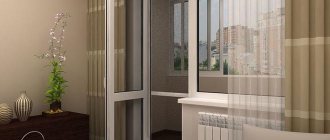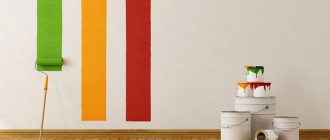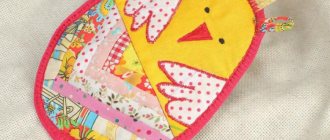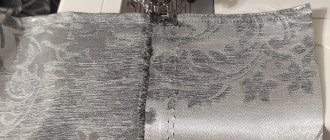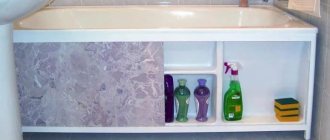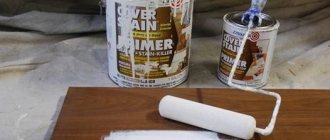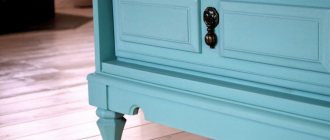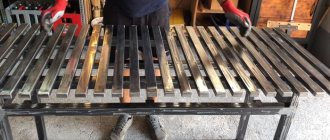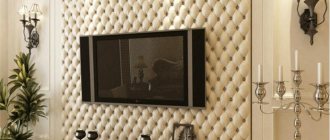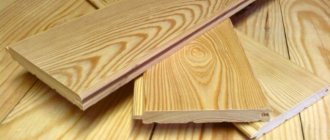Parquet boards are considered one of the most beautiful and reliable building materials for installing flooring in an apartment or private house. Over time, such products lose their attractiveness under the influence of external aggressive factors. The decorative coating wears out, cracks and dents appear on the surface, and the floor begins to creak. From our article we will learn how to repair parquet boards.
Do-it-yourself partial parquet repair
Let's consider several cases of partial parquet repair, which you can do yourself.
- The parquet has lost its former brightness, has become worn or faded. For cosmetic repairs, you need to sand or sand, and then apply a new decorative protective layer. Prepare the varnish according to the instructions and apply it using a wide brush or roller along the parquet texture line in several layers. After 5 days, you can carefully bring the furniture into the room, and after 1-2 weeks the varnish will dry completely.
- Repairing chips and cracks in parquet flooring. If the gap is small, it is enough to clean it of debris and fill it with mastic. For large chips, more than 5 mm, thoroughly clean the flaw, deepen the gap and insert a wooden plank of a matching color, coated with glue. We plaster the repair area and varnish it.
- Scratches and shoe marks. Try to protect the space in the hallway with rugs and protect the parquet from walking on it with shoes. Stripes can be removed with special parquet care products, and small marks from impacts or scratches can be retouched with a pencil.
- Repair of old, rickety parquet. If the parquet floor has been in use for a long time in the house, or the air humidity in the room is often low, some parquet planks may become loose over time.
Local repairs can be made as follows: using a chisel, we break the loose board, and in its place we install a new one of identical material and color. The recess in the floor is carefully leveled and cleaned of glue residues; sometimes the hole under the cleaned parquet is filled with heated bitumen mastic.
It is worth noting that if the area of loosening of the parquet is too large, then it would be more advisable to replace the floor with a new one.
Peeling of planks: how to repair
Such a defect may be due to a number of reasons:
- bad glue or mastic;
- high room humidity;
- violations of technology when installing parquet floors.
Depending on the type of foundation, the problem has different solutions.
Concrete base
The nests of the planks are thoroughly cleaned of old mastic using a solvent, as well as of dust and debris. The base is primed and dried. Then, after applying mastic or parquet glue, the plank is glued into place. By the way, when repairing, you can also use old mastic for gluing, heating it with a hairdryer or heater until it becomes viscous.
Wooden base
The nest of the planks is cleaned and coated with carpentry or casein glue. The loose planks are put back and nailed to the edge. The nail heads are compressed with pliers and hidden below the surface of the laid plank. The recess is covered with sawdust, which was previously mixed with wood glue. And as always, they sand it after drying and varnish it.
Repairing old parquet floors when the color of the parquet changes
The color of parquet may change due to exposure to sunlight. Moreover, different woods have different reactions to ultraviolet radiation. Any type of tree requires a certain time to mature. Wood that has a shorter ripening time becomes darker faster. Such a type of wood, for example, is cherry. If you properly care for the floor covering, the color change of the parquet can be significantly delayed. Here are some care tips:
- If water is spilled on the parquet, it must be removed as quickly as possible. If the strips are damaged, they must be replaced.
- When the floors are completely laid, you should give some time for the parquet to mature. Only after this can it be covered with carpets.
- Any defects in the parquet floor that appear over time will certainly change its appearance to one degree or another. In order to restore the attractiveness of the parquet board, you can scrape it.
- It is always easier to prevent any problem than to solve it. Therefore, regular and qualified repairs will be more expensive than proper maintenance of the parquet floor.
In order for the parquet to last longer without repair, it is recommended to do the following:
- Install a humidifier in the house.
- Periodically polish the floors with polish.
- Felt pads should be placed on the legs of tables, chairs and other heavy moving objects.
Methods for eliminating cracks and chips
In cases where chips form on the parquet planks, it will be more difficult to cope with such a problem.
To do this, you can use one of the effective means:
- wood putty;
- hot putty;
- a self-prepared composition of sawdust and epoxy glue.
Before you begin to repair chips on the parquet, you need to vacuum them, since the area of the recess must be clean, otherwise the putty will not adhere well to the surface of the wood (pro
Types of work
Before you restore parquet with your own hands, you need to master several simple manipulations. Let's talk about each of them in more detail.
There are ready-made putty pastes and mixtures on sale that can be used to fill cracks and crevices (for more details: “Which putty for parquet is best suited”). However, in some cases you can prepare such a mixture yourself. To do this, you will need remnants of the old parquet left in reserve. They need to be sawn into small sawdust and mixed with parquet varnish to a paste-like state, or with epoxy varnish in a ratio of 4:1. This grout is ideal if you want to accurately match the tone of the wood.
Imitation of joints
You can disguise the putty by simulating joints, which can be done using a ruler and an awl:
- First you need to wait a little until the putty hardens to the state of gelatin, that is, it will be plastic, but not sticky. Alkyd and uralkyd varnish hardens within a few minutes after application and quickly crystallizes.
- For straight joint lines, furrows are drawn with an awl under a ruler.
- Wavy lines are pressed with a metal ruler.
- If the putty has already hardened, then to create false joints it will have to be scratched with an awl.
Manual looping
To scrape small areas of parquet, you can use a hand scraper, which can be purchased at a specialty store. If desired, a hand scraper can be made from a plane blade.
Sanding with feet
You can sand small sections of parquet using two types of sandpaper glued to the soles of old shoes. For roughing, paper No. 40 is suitable, and for finishing – No. 80. Sanding with your feet is faster than by hand, and the processing is more delicate than, for example, with a whetstone.
Getting rid of annoying creaking floorboards
Unfortunately, old parquet, which can be repaired for various reasons, often begins to creak and make completely unpleasant sounds. Many people think that it is impossible to get rid of squeaks, but this is not at all true - there is a way!
The most important task is to determine the cause of unpleasant sounds. This is often due to the fact that the craftsmen who laid the parquet violated the installation technology. Creaking can also be caused by installing parquet boards on bitumen mastic. Sometimes unpleasant squeaks can occur due to peeling of the coating from the screed - the layers come into contact with each other, which causes an irritating sound.
Defect Elimination Technology
If you plan to repair the parquet yourself, you will need step-by-step instructions for each type of work. Let's look at ways to eliminate common flooring defects and breakdowns.
Mechanical damage
Cracks are filled with a special compound and rubbed with sandpaper.
During operation, careless handling causes scratches and gouges to form on the coating. The coating can get scratched even if you move a heavy chair without lifting it.
Types of mechanical damage and methods for eliminating them are discussed in the table:
Fill with colored putty. If the color is chosen accurately, the restored areas will be invisible.
The sequence for restoring deep scratches on parquet:
- We clean the coating from dust using a vacuum cleaner.
- Fill the crack or scratch with putty.
- After the putty has dried, sand it down with sandpaper.
- We remove all dust generated during the grouting process.
- Apply a thin layer of varnish to a clean, dry surface.
When black marks form, we wipe them with polymer mastic.
Wax putty is applied in molten form, and is preheated with a gas or battery-powered wax melter. To learn how to remove small scratches, watch this video:
You can independently prepare putty from two-component epoxy glue with the addition of sawdust until a homogeneous mass is obtained.
Timely restoration of the coating will help maintain the ideal appearance and integrity of the floor for many years.
Mechanical scraping
After sanding, the parquet is varnished again.
To make the parquet floor shine, it is rubbed with wax-based compounds, mastics, various oils, or varnished.
With careless handling, heavy foot traffic and cleaning using abrasive products, the coating can wear off and lose its shine and color. In case of significant tarnishing of the surface, sanding and sanding are carried out with further coating with a decorative layer.
In case of significant tarnishing of the surface, sanding and sanding are carried out with further coating with a decorative layer.
After rough sanding, go over the surface with fine sandpaper.
Sanding is the removal of the top layer of parquet using a special apparatus with sharp metal knives that remove the decorative coating and the top layer of wood.
Sequence of scraping:
- We remove the baseboards and remove dust with a vacuum cleaner.
- We dismantle all protruding fastening materials (screws, nails).
- We perform rough sanding, which includes removing uneven surfaces and old varnish. This procedure is performed using a surface grinder or drum machine.
- Use wood putty to seal joints, seams and irregularities.
- Sanding the parquet floor is done with sandpaper in the direction along the dies. The appearance of the surface will depend on the quality of this stage. We clean all the unevenness of the parquet and the protruding plaster mixture.
- Vacuum the floor surface.
- Apply varnish in 3 layers. Apply each subsequent layer after the previous one has dried. Apply the varnish with a roller or wide brush.
- We install skirting boards. To learn how to achieve high-quality sanding of a parquet floor, watch this video:
To remove the stickiness of the last layer of varnish, after it has completely dried, wipe it with a cloth slightly moistened with soapy water.
Manual scraping
Let's look at how to repair parquet using a manual scraper, which is a tool for restoring the top layer of parquet boards manually.
The device is a plane, the blade of which is bent with a hook. With its help you can restore small areas of the floor.
Manual restoration will take a lot of time, and the result will be worse than using professional equipment.
Imitation of joints
On the puttied surface, you need to create imitation joints between the dies.
To complete this work you will need a metal ruler and a shoe awl. The putty should set well, but still be soft. Many mixtures harden within a minute, so you need to make the joint quickly.
If the joint is smooth, apply a ruler and draw a line with an awl. A curved connection can be formed with the edge of a ruler. If the putty has hardened, you can scratch a line along it under the ruler.
Fighting the squeak
If one die creaks, it may have come off; you just need to put it in place and fix it.
If your entire floor is creaking, you first need to determine why this is happening.
Possible causes of parquet creaking:
Removing deep scratches
Hard wax will help deal with more serious damage. If there are many such defects, it would be best to purchase a ready-made repair kit that will last you a long time.
What you will need for work:
- spatula with grater;
- bars of hard wax;
- wax melter;
- colorless varnish corrector;
- wipes for grinding and polishing.
Repair kit
Step 1. Damaged areas are cleaned with a damp cloth to remove dirt and dust and dried. If necessary, degrease.
Step 2. Using the sharp edge of a spatula, process the edges of the scratch, removing burrs and crumbs of material. If the edges are too torn and the fibers stick out, turn the spatula over and press them into the damage with the blunt end.
Treating sharp edges with a spatula
Step 3. Select wax according to the color of the parquet board. Usually it takes at least three bars of different shades to achieve the best match. And to achieve depth of color, additionally take a transparent filler, which is also included in the set.
Shade selection
Step 4. Take the wax melter, remove the protective cap from it and move the yellow button to the “ON” position. After this, you need to press the blue button and hold it for about 10 seconds to turn on the device. Wait a few more seconds for the tool to heat up. During heating, the red indicator located at the front of the device should light up.
The wax melter needs to be turned on
Step 5. Use a hot tip to scoop up wax in small portions from different bars, add filler and carefully apply it to the scratch.
Waxing
Advice. To achieve the desired shade, you need to start applying with the lightest tone and finish with the darkest.
Step 6. The layer of wax must protrude above the surface, that is, it should be applied in excess, filling all visible depressions and pores around the scratch. The tip is periodically wiped with a clean cloth to make it easier to work with.
The tip is wiped with a napkin
Step 7. Having filled the recess, allow the wax to cool for 30 seconds, after which the excess composition is cleaned off. To do this, apply the spatula with its ribbed side to the surface and rub the treated area with short movements. Movements should be directed along the fibers of the parquet board.
Removing excess wax
Step 8. When all the excess has been removed, you need to clean the spatula from any adhered wax. This is done using a lid on a spatula, which has a serrated edge. The lid is removed, the teeth are placed against the slots on the work surface and all excess is cleaned out.
Cleaning the spatula
Step 9. Remove crumbs of the composition from the surface of the board and apply wax again, forming the desired texture on the restored area. This process is quite painstaking and requires attention and accuracy, so be patient. The more carefully the texture is drawn, the more invisible the damage site will be.
Processing with a sharp spatula. Movements along the wood fibers
Applying darker wax
Step 10. Excess wax is again scraped off with the ribbed side, then the spatula is turned over and the surface is smoothed with a thin edge, running along the fibers of the coating. Sweep away the crumbs of material and check the quality of the seal. If there are depressions, noticeable pores or the pattern is not clearly defined, apply a little more wax.
Removing excess applied layer. Movement along the fibers
Advice. The wax melting device is designed to operate continuously for half an hour, but sometimes the tip overheats excessively and begins to smoke. In this case, you need to press the blue button and let the tool cool, then thoroughly clean the tip with a napkin.
Step 11. When the texture is completely restored, it is necessary to sand. To do this, remove the gray abrasive sponge from the spatula lid and treat the retouched area with uniform movements. There is no need to press hard so as not to remove excess.
Grinding
Step 12. Now you need to ensure protection from contamination and abrasion. To do this, take a transparent corrector varnish, shake it vigorously for 15-20 seconds, and remove the protective cap. To apply varnish, you first need to remove the air from the corrector: placing the rod over the napkin, squeeze the corrector in the front with two fingers (indicated by the word PRESS). Next, lift the corrector vertically and hold it above the napkin, continuing to squeeze until the varnish comes out. Remove excess with a napkin, and then carefully cover the restored area with varnish. Movements should be directed strictly along the fibers.
After the varnish has dried, you can slightly adjust the level of gloss using a special double-sided sponge. If you rub with the white side, the surface will become matte; the green side, on the contrary, will add gloss. After this treatment, it is almost impossible to determine the location of the damage; the parquet board looks like new again.
Polishing
Preparing the premises
Before you start repairing the parquet, you need to prepare the room. Furniture and all interior items are removed from the premises. The craftsmen note that it is enough to take out only the furniture and everything that is located on the floor. But you should understand that restoring parquet is accompanied by dusty work, so it makes sense to completely vacate the room and wash the floor.
After this, the condition of the floor covering is assessed and the scope of work is determined. To understand how to renew old parquet, you need to determine the type of damage.
Note. It is better to outline floor defects with chalk to eliminate the possibility of missing any area.
Depending on the complexity and type of damage, the work may require:
- parquet grinding machine for parquet (surface grinding);
- angle grinder – “Sapozhok” SO?337;
- sandpaper of different grits (number from 40 to 120);
- household or construction vacuum cleaner;
- putty (you can knead it yourself using wood dust extracted from a vacuum cleaner);
- finishing decorative coating for parquet: varnish, wax, oil, tinting mixtures.
About the types of defects: the scale of the problem
You need to understand that the resistance of the coating to external influences, including mechanical damage, is affected by the type of wood used for its manufacture. The more expensive and stable the parquet, the less likely it is that dents will appear on it even after many years of active use.
It is obvious that parquet boards, compared to solid or piece parquet, are not so resistant to mechanical damage, so they are much more likely to be repaired. Causes of vulnerability:
- soft bottom layers;
- relatively thin facial layer;
- not the most stable varieties of trees at the base.
Engineered parquet boards are considered the most durable, resistant not only to dents, but also to moisture and temperature changes.
No matter how durable the coating is, it does not guarantee one hundred percent protection from various types of influences.
However, regardless of the type of wood, not a single type of parquet or parquet board is immune from damage over time. Dents and scratches are the most common problems encountered. Depending on their type, an effective method is chosen to solve the problem.
So, the most common type of dents are those formed as a result of contact of the floor with women's heels. Sharp and thin heels, often with iron heels, mercilessly damage wood, violating the integrity of the varnish or oil coating, leaving unaesthetic dents on the surface.
Heels can leave not only deep dents, but also large scratches.
Heel marks are an unpleasant phenomenon, but fixable. You can get rid of them by local repair if there are few marks and by scraping if the surface is disfigured by marks everywhere.
It is worth understanding that it is much easier to restore parquet boards with your own hands at home than in public premises with other scale problems. Small dents can be removed without using a sander.
Restoring the parquet surface
Wood looks great, gives the floor a wonderful look, makes the atmosphere softer, and the room itself cozy. But unfortunately, over time the wood darkens and loses its attractive appearance. The process of restoring the top layer of parquet is quite simple; it does not require special efforts, knowledge or skills. To update the floor color with your own hands, you will need the following:
- Skirting boards are removed.
- The layer of old varnish is removed. For this purpose, scraping or grinding machines are used. And in corners and in all hard-to-reach places on the floor, an angle grinder will do. You can also remove the varnish with a special industrial hair dryer. The varnish is heated and then easily removed with a spatula.
- The surface is thoroughly cleaned of dirt and dust. After which all damage is clearly visible. putty
is used ; it copes well with all cracks, scratches, etc. - The surface is evenly treated with stain. But only if there is a desire to change the color of the parquet floor.
- If no damage is found, then the surface is treated with a grinding machine with a fine-grained emery attachment. By grinding, all unevenness, roughness and dark areas are eliminated. The surface becomes more uniform and monochromatic. Do not forget that during restoration work only soft shoes with shoe covers are used.
- A vacuum cleaner is used for thorough cleaning. There must be perfect cleanliness.
- Now the first layer of varnish is applied. This layer is more of a primer than a decorative or protective one. The varnish is applied with a roller or brush, after which the surface is sanded again with zero sandpaper. Next, another layer of varnish is applied. Once the varnish is completely dry, the surface is sanded again. The number of layers can be up to nine. Parquet varnishing occurs strictly in the direction of the wood grain. Instead of varnish, you can choose mastic.
- After all necessary repair procedures,
the surface dries for at least three days. This requires certain conditions: closed windows and doors (drafts are extremely unacceptable), temperature 17-22 °C, humidity 40-70%.
Most often, parquet floor owners encounter problems such as scratches. They appear when moving furniture and in other similar situations. Removing scratches is possible in several ways:
- Using a wax pencil
. This method is very economical, fast and simple. But it is only suitable for small, shallow damage; - For deep scratches, you will have to clean a certain area of the floor from the varnish. Then the layer of parquet itself is removed until the scratch becomes almost invisible. After vacuuming, the damaged area is primed, puttied and varnished.
Using a wax pencil and special putties to remove scratches
Even hardwood floors are susceptible to potholes and chips after strong impacts. In such cases, parquet restoration involves the following procedure:
- The layer of old varnish is removed and an operation is carried out to identify all damage.
- The surface is scraped and a thin layer of wood is removed. If the problem is not resolved after the first scraping, you will have to repeat it again.
- Chips can be removed using simple putty. Sanding dust is added to the putty mixture so that the restoration area does not look much different from the wood and is not noticeable. Putties are spread over the surface with a wide spatula.
- After the putty has completely dried, the surface is sanded and thoroughly varnished.
Necessary actions
To restore the color of parquet you need to do the following:
- First, remove the baseboard.
- Then the old varnish is removed using a grinding or scraping machine.
- Afterwards, the surface is thoroughly cleaned with a vacuum cleaner and checked for damage.
- If necessary, putty; if there are no defects, you can proceed to sanding with a grinder with a fine-grained blade to eliminate roughness and remove darkened areas.
- After finishing sanding, the surface must be thoroughly cleaned of dust again, only then can the first layer of varnish be applied (certainly along the fibers).
You can see the grinding process in the following video:
To change the color, stain is often used, which is also usually varnished.
Varnishing is done using a roller or brush. When the first layer dries, it is sanded with zero sandpaper and varnished again, and then sanded again.
Two-component varnishes are considered the best, but they have a significant drawback - a very persistent unpleasant odor, because they contain formaldehyde resin. If during renovation it is not possible to completely empty the room of its occupants, you need to use a water-based varnish. It hardens quickly and does not frighten you with its smell.
Getting rid of scratches
You can get rid of small scratches using a wax pencil.
The most common surface damage is scratches. How to restore parquet in this case? There are two options.
Elimination of minor scratches
Small, not very wide and deep scratches can be removed using a special wax pencil. If they are deep enough, you should use silicone putty or melted wax. The hardened surface is sanded with abrasive sandpaper and varnished.
Removing deep and wide scratches
Defective areas are completely cleared of varnish and the layer of damaged wood is removed. In the absence of experience, it is not always possible to achieve the desired result the first time. At the end of scraping, the room is thoroughly cleaned with a vacuum cleaner. Next comes primer, putty and varnish.
You can see how to putty in the following video:
Repairing chips and potholes
Parquet is made from hardwood, but even such wood is not able to survive a strong blow from an object with a higher density. As a result, bumps, potholes and chips appear.
Parquet restoration consists of the following:
- First, the surface is cleared of varnish and checked for damage.
- Then it’s the turn of looping. Unevenness and potholes are leveled by removing a thin layer of wood. If necessary, the procedure is repeated several times until strong changes disappear.
- Chips are leveled using putty. Small chips that remain after sanding are added to it so that the entire surface looks the same. The mixture is leveled with a wide spatula.
Putty is used to eliminate small cracks and chips
Important! Sanding allows you to “refresh” the parquet. Recommended frequency of the event: once every 6 years
When the putty dries, the parquet is sanded and varnished.
Getting rid of chewing gum and plasticine
Be that as it may, it is difficult to attribute them to the desired decor. If you try to remove the jewelry with a solvent, stains will remain. It's better to use ice. It is placed in a plastic bag and placed on the contaminated area. After 10-20 minutes, the chewing gum will separate from the surface on its own or will become very pliable and can be removed without problems.
Do-it-yourself parquet repair at home - methods and tips
Parquet is a floor covering made of wood. Parquet flooring is quite durable, has good sound and heat insulation properties, and is an environmentally friendly material. Parquet flooring comes in a wide variety of designs. It will create an atmosphere of warmth and comfort in any room and is compatible with all interior styles.
As for repairs, parquet here also has one significant advantage: if the floor is damaged in one place, then the parquet can be replaced without affecting the entire coating, but only in fragments.
Despite the large number of advantages, parquet flooring requires special treatment. Wood is very sensitive to humidity, temperature changes, and mechanical shocks; the appearance of varnished parquet is easy to damage simply by moving furniture from place to place or wearing high-heeled shoes.
Wear of floor covering - restoration
Over time, the floor loses its former luxury and attractiveness, and then they turn to a reliable method of repairing a “seen life” coating - sanding (only the floor must be well secured for this). The whole process can be divided into three stages.
123 Note Remember, the last layer of varnish dries for at least three days.
Remember that the beauty and durability of our flooring depends largely on its proper use rather than repairs. The following will help a lot with this: an air humidifier, special polishes that can be used to periodically rub them, felt pads on all heavy moving objects.
2021 prestigpol.ru
Swelling of parquet after flooding the floor with water
The worst thing for a wooden floor is exposure to water.
The tree swells, heaves and loses its original properties. The degree of destruction of the floor in the area of the bay largely depends on the quality of the wood and the laying of the parquet itself. If the area of damage is small and the parquet planks are not broken, then to repair the parquet you need to dismantle the floor surface and replace it with identical boards using the technology described above.
If the area of floor repair is too large, then it is better to replace the parquet floor with a new one.
To avoid sagging of the parquet or the appearance of depressions, you need to make sure in advance the quality of the work being performed. Irregularities on the parquet flooring can be eliminated by sanding, and if the planks sag, the floor will have to be dismantled.
If you decide to repair a parquet floor with your own hands, do not skimp on materials and glue.
Repairing parquet in Moscow, St. Petersburg or Kyiv will not cost much, and professional workers will do the job efficiently and quickly.
Repair or restoration of old, worn parquet in an apartment is carried out using sanding. The process involves removing the top layer of varnish using a tape machine. The floor is puttied, thoroughly sanded and several new layers of varnish are applied.
Experts recommend sanding your parquet every 5-6 years; this will preserve the beautiful appearance of your floor and protect you from costly repairs and replacement of the floor in the future. It is better to entrust the scraping to specialists. since it is very difficult to do such work manually, and workers will come to your home with ready-made equipment.
You can entrust parquet repair to a private craftsman, but keep in mind that although the price of such repairs may be less, the quality of the work will differ significantly from professional work, and it is better not to skimp on construction.
Whether it is a local repair or a complete replacement of the floor, in any case, the parquet should serve for many years without peeling or creating squeaks when walking. The appearance of such defects largely depends on the materials that the master chooses during installation.
The materials for parquet repair recommended by craftsmen in Moscow are of high quality and reliability. Professionals will repair or restore the floor at a low price and with a guarantee that the coating will serve you for many years.
Protection of parquet from furniture, from pets, as well as from the owners themselves
Movable furniture can be a real disaster for parquet flooring. Legs, wheels - all these are elements that cause scratches, dents and other characteristic damage.
Felt pads (which are glued to the legs of cabinets and sofas) or transparent silicone-based mats will help save parquet flooring from the effects of movable furniture. The photo shows an alternative solution that is suitable for all types of flooring.
Protecting parquet flooring from the claws of pets, as well as from the sudden appearance of wet spots on the floor covering, comes down to vigilant control over your pets. And if it is impossible to organize such control, then it is better to abandon either the parquet floor or the idea of getting yourself a four-legged friend.
Oddly enough, the owner of the premises should first of all protect the flooring from himself. Here are a few simple rules that the owner of a house with parquet floors must follow:
- you cannot walk around the house in shoes with heels or rough soles;
- Offer all your guests to change into soft slippers;
- Handle sports equipment (such as dumbbells or barbells) carefully.
Sanding parquet
Parquet scraping is a type of work that involves removing a large layer from the floor surface - up to 1.5 mm
When performing scraping, it is important to adhere to the sequence of work. If the damage to the floor is insignificant, you can immediately sand the parquet
Parquet sanding is a type of work, the essence of which is to remove a thin layer of wood - 0.5-1 mm. They sand the parquet in several directions using special equipment that allows you to achieve the ideal level of smoothness of the parquet surface.
The purpose of the treatment is to remove the worn surface layer of the coating and part of the surface of the parquet strip or solid board.
Note. Sanding and sanding are accompanied by the appearance of dust. Despite the fact that modern equipment is equipped with a dust collector, after repairs it is necessary to clean the room.
Basic rules for caring for wooden parquet
Caring for parquet comes down to proper cleaning and periodic treatment of the floors with protective compounds.
Luch ok User FORUMHOUSE
Cleaning parquet is mainly done with a vacuum cleaner. When cleaning, use an attachment with a soft brush that does not leave scratches. Try to do wet cleaning no more than once every two weeks. For cleaning, use special products (in this case, for varnished floors).
Polishing parquet (1-2 times a year) prevents abrasion of the top layer and slows down its aging. Parquet is polished with special compounds (water-soluble and oil-based). Water-soluble polishes are used for varnished floors. These are inexpensive compositions that, with proper processing, allow you to obtain a fairly shiny and aesthetic coating. At the same time, wax-based compositions intended for oil-impregnated parquet have a higher cost, but after their application the coating retains its attractiveness longer.
You can take part in discussions regarding the technology of restoration of parquet flooring by visiting the corresponding topic on our portal. You can learn more about the selection and repair of natural floors, as well as the characteristics of modern floor coverings, by visiting the FORUMHOUSE section, which contains practical experience and recommendations from our users. A thematic video will tell you in detail about the features of caring for wooden floor surfaces during their operation.
Materials for restoration
To protect the parquet floor from external influences, it is opened with special varnishes.
There are 4 types of parquet varnishes:
- Alkyd and uralkyd varnishes. They are inexpensive, do not emit toxins, dry very quickly, so you can be indoors within an hour after varnishing. However, such varnish will last no more than 10 years. Uralkyd varnishes are somewhat more durable, although they are more expensive. As a rule, they are used for short-term repairs followed by sanding and varnishing, as well as around the perimeter of the room.
- Based on epoxy resins. Such varnishes provide a durable and reliable coating for 30-40 years, although they are not cheap. As they cure, they release toxic volatile substances, so you should not start working without personal protective equipment (gloves, respirator, goggles). Windows should be open, but the door to adjacent rooms should be tightly closed. It will take about a week for the epoxy varnish to harden and gain density. Only after this can you be in the room.
- Acrylic varnish consists of a base and hardener, which are mixed immediately before application. This composition is practically non-toxic, but much more expensive than epoxy. With proper care, the service life of the coating will be 50 years or more.
- Water based. Rather, it is a finely dispersed suspension of some polymer, for example, PVA, in water. This varnish dries in a day, while it is non-toxic and inexpensive. Provides long-term protection to wood by penetrating deep into its structure. Mastic can be applied over the coating. The treated surface becomes less sensitive to minor mechanical damage. However, such varnishes somewhat change the color of the wood and quickly fade in direct sunlight.
Varnishing and polishing
Before you start varnishing the parquet, you need to wait two days for 80% of the dust to settle. On the morning of the third day, you need to wipe the wood with a very slightly dampened rag, and after 5-6 hours, start applying varnish.
The first layer is performed with a special priming varnish. Apply it with a roller and take it only from the bath, and not pour it onto the floor, so that stains of different saturation do not appear. At intervals of a day, another 2-3 layers of parquet varnish are applied; before each application, the surface is treated with a felt disc to remove adhering dust.
The notorious transparency, reminiscent of young amber, can only be achieved with a varnish layer of 0.4–0.6 mm
This is four to five layers of varnish, laid on top of each other as tightly as possible, this is the whole importance of intermediate polishing. The varnishing is completed with two layers of a two-component finishing varnish, absolutely transparent and highly resistant to abrasion.
published
PS And remember, just by changing your consumption, we are changing the world together! econet
Small voids near baseboards
The cracks that are located near the baseboards are probably the most unpleasant. They start by removing the baseboard. Between the wall and the outer board, there should usually be a spreading wedge inserted: if it gets loose, just strengthen it.
If instead of an expanding wedge you find foam, press the plank away from the wall and install a suitable wedge in the resulting space.
Wide holes
There is no point in filling a deformation of more than 5 mm; it will crack anyway. We will fight such deformations “by contradiction” - first we will deepen them. If the edges are uneven, they should be trimmed with a chisel and the resulting groove should be cleaned.
We cut out a plank from suitable wood, grease it with wood glue and hammer the insert between the planks.
We coat it with varnish, having first cleaned and sanded the repair. Gaps in parquet are formed mainly due to significant changes in humidity throughout the year. They can be prevented by maintaining relative humidity of about 20% in winter. For these purposes, in particular, an artificial air humidifier is used.
How to remove wide holes in parquet
If the gap in the parquet is too wide and the situation cannot be corrected with putty, then experts recommend doing the opposite. This means that the hole needs to be expanded even further - we deepen it with a chisel or an awl, and smooth out the edges.
Then you need to take a pre-prepared wooden block, coat one side with wood glue, not forgetting to treat the sides of the insert, and “embed” it into the damaged floor covering. After this, the repair area is cleaned with fine sandpaper and covered with varnish or mastic.
Please note: wide cracks often appear on parquet flooring laid in a room with constant changes in air humidity levels. To prevent this situation, it is recommended to artificially humidify the air in winter.
Frequent parquet defects and their repair
Any floor covering loses its original appearance over time. Parquet is no exception. To increase its service life and maintain a neat appearance, parquet flooring must be maintained using various special products - oils, waxes, mastics.
However, they often provide only a temporary effect. If, when laying parquet, the technology was initially violated, and then such a floor covering was used for a long time and was subjected to mechanical stress, then defects appear on it. Correcting these defects in order to return the parquet to a neat appearance can only be done through repairs.
Defects on parquet
- Examples of such defects are:
- scratches and gouges on the parquet surface,
- loosening and drying out of individual planks,
- the appearance of a squeak when walking on it,
- partial wear of the parquet flooring,
- the appearance of irregularities on its surface,
- swelling after flooding the parquet floor with water.
The photo below shows standard scratches on parquet.
To correct these defects, you can try to repair the parquet, partially restoring it, replacing a separate section, or replacing the entire parquet completely.
It can be difficult for a non-specialist to make a definite decision, so it is better to contact a specialist so that he can make a decision on the parquet repair on the spot.
Do-it-yourself parquet repair
For those who decide to do such repairs themselves, we can offer some recommendations. Read them and, perhaps, you will still be able to eliminate some defects on your own.
Potholes and scratches
Small scratches on parquet floors can be easily removed with a special retouching pencil. A retouching pencil for parquet from the Profix brand, which is sold everywhere, is quite suitable. You should choose it exactly to match the color of the parquet.
If such defects are deep, especially if there are potholes on the parquet, a pencil will not cope with them.
In this case, putty is used, matching it to the color of the floor.
- Necessary:
- apply it (putty) in an even layer,
- wait until it dries,
- sand the repaired areas with sandpaper,
- remove dust thoroughly,
- and apply a new coat of varnish on them.
For such repairs, Bona water-based paste, which has several different shades, is well suited. For example Gap Master.
Or Bona Parektt Repair mixture will do.
Loosening and drying out of parquet planks
If individual planks on the parquet floor begin to crumble, dry out, begin to sit loosely in place, and a lot of dust begins to appear on the floor from them, then they need to be replaced.
You can do such repairs yourself, but to do this you will have to go through a very large section of the floor or, in the case of a large number of defective planks, dismantle the entire parquet. Whether or not to carry out such repairs is up to the owner to decide. Maybe it’s worth re-laying the laminate or parquet board...?
Creak
The cause of parquet squeaking may be an uneven base, the separation of individual planks from it, or old bitumen mastic on which it is laid. In all cases, partial or complete re-laying of the parquet floor is necessary to eliminate this defect.
Filling parquet with water
If the parquet floor, after being flooded with water, swells and rises above the base, tearing away from it, it needs to be replaced.
In the case where a small section of parquet has dried out and deformed after exposure to water, but remains attached to the base, you can try to restore it to its original form through restoration.
It is better, of course, to consult with a specialist and decide on the advisability of this or that type of repair.
Irregularities in parquet
This defect occurs most often due to unevenness of the base. In this case, it is necessary to dismantle the entire parquet and level the base using cement mixtures, self-leveling screed or self-leveling putty.
General parquet wear
This defect is corrected by scraping using a tape machine, which removes the old varnish and smoothes out unevenness.
After this, the defective areas are finely ground with a surface grinder, the cracks are puttied and sanded, the surface is primed and varnished.
You can find out more detailed information about services for restoring old parquet by phone or on the “Parquet Restoration” page.
How to get rid of squeaks and other problems that require restoration of old parquet
The problem of a creaking floor is familiar to many, because it is considered one of the most common; it arises due to the friction of the planks relative to each other under the influence of weight. In this case, you can try to repair the parquet yourself using any type of fastener. These can be screws, self-tapping screws or other options screwed flush with the coating. After screwing in the element, the installation site is hidden using putty of the desired color.
Another reason for unpleasant sounds is the separation of the floor covering from the base. Here, an important task is to return the boards to their original position.
In some cases, in order to eliminate the squeak, you will have to completely or partially remove the parquet.
To repair creaking parquet flooring you may need:
- self-tapping screws, with the help of which individual strips are tightened to the base;
- an adhesive mixture injected into the gap between the slats using a syringe or syringe with a thin plastic tip;
- Polyurethane foam, due to its strong swelling, is recommended for use least often.
The most expensive parquet repair will involve complete or partial dismantling of the planks, after which they are re-installed, and the most unsuitable parts are either adjusted or replaced with new ones.
The third reason for the friction of the boards against each other is considered to be a violation of the technique of laying the dies and an incorrectly calculated distance between them. In this case, local repairs of the parquet are not allowed, because in any case it will be necessary to completely remove all elements, as well as move the logs, after which the coating will be laid again.
On a note! If one joist moves during assembly, do not lift the entire parquet completely. It is necessary to disassemble the adjacent part of the covering, use a hammer to knock the joist into place, and then reinstall the parquet.
If some parquet tiles have peeled off, you can fix the problem using self-tapping screws and a screwdriver.
In addition to the reasons listed, creaking sounds can also be caused by the absence of an expansion joint, which should be located between the edge of the parquet and the wall. In order to properly make a seam, after laying it is necessary to cut off part of the covering to form a small gap, the optimal size of which is 1-1.5 cm. There are other reasons why it may be necessary to repair panel parquet or conventional plank covering.
The appearance of a difference between shields or individual elements. In this case, it is necessary to sort out a significant area, because the cause of the violation may be deformation of the base. If a step of small height has formed, you can try to raise the protruding planks, cut off part of the coating at the base, or sand it.
Darkening of the surface. The main reason why old parquet has to be restored is considered to be the contact of aggressive chemicals on the surface, which quickly penetrate deep into the wood. Another reason is the wrong type of tinting or other coating. In this case, the only option for parquet repair is scraping and sanding, after which varnish, tonic or an oil-wax mixture is applied.
The most difficult cases
Sanding old parquet and subsequent varnishing is always quite expensive, because it requires time and labor. However, there are a number of cases when the condition of the coating leaves no other choice.
So, the most labor-intensive restoration of parquet with your own hands will be required in the following cases:
- The parquet floor looks unkempt, trampled, with significant abrasions, gouges, and cracks in the planks. In such a situation, the old parquet can still be preserved, although you will have to work hard. However, we recommend that you entrust the restoration of old parquet in this case to specialists - it’s cheaper and faster.
- Due to water flooding, the parquet covering swelled across the entire floor plane, and in some places the planks became detached from the base. This problem can only be solved by completely replacing the parquet. True, some planks can still be reused after drying. However, sanding and varnishing are necessary.
- The parquet canvas has become loose, the wood has turned black, and when pressed with an awl, it fits into the plank by 5 mm. This indicates that the parquet floor has begun to rot and mold. In this situation, there can be no other options other than a complete replacement of the parquet. In addition, the room needs to be thoroughly dried and the subfloor needs to be updated.
In all other situations, you can safely take on restoring the parquet with your own hands. Such work will not require much skill or time from the owner. Let us note that in case of simultaneous renovations in the apartment, the restoration of the parquet should be undertaken last.
Repairing wet parquet flooring
Swelling of the planks after the parquet gets wet is the most unpleasant type of damage to the floor covering. This can happen as a result of burst pipes, when the floor is completely under water. Wood has the ability to absorb moisture well, after which it becomes deformed. The only way out of this situation can be a complete replacement of the entire coating.
If you do not dismantle wet parquet flooring, mold will immediately appear underneath it and they will have to be replaced in any case, but during this time the fungus can spread to the walls and an unpleasant odor will appear in the room, which will not be easy to get rid of. For the above reason, parquet elements must be dismantled. You need to clean the base from glue, dry it well, and then just start installing the final coating.
It will take a long time to dry the planks, and before laying a new parquet floor, you need to make sure the concrete base is dry. For this purpose, the concrete surface is covered with a thick polyethylene film and waited for 12-15 hours. After the allotted time, the waterproof material is inspected and if it is dry, then you can begin installing the parquet floor. The presence of even a small amount of condensation on the film indicates that the concrete layer must still dry out and it is too early to lay the decorative coating.
If a small area of the parquet surface gets wet, then not only these parquet floors will have to be lifted, but also the floor elements located around the emergency area. This is necessary to ensure that the rest of the coating is dry.
You can try to dry the dismantled dies, but, as a rule, you have to purchase new products, matching them by color and texture relative to the rest of the parquet surface.
How to remove swelling from the surface of parquet
Schemes for polishing parquet.
If you are faced with such an unpleasant phenomenon as the appearance of swelling on some parts of the parquet, do not panic. Even if this phenomenon is not capable of causing positive emotions, it can be eliminated.
Parquet swells in case of improper use or violation of installation rules.
In the latter case, you can call the craftsmen who performed this work and ask them to fix the defect.
You can eliminate the swelling of the parquet only by completely re-laying it.
If the swelling is small, you can try the following:
- The swollen surface must be heated with a hair dryer. You can also use a household appliance, but then you need to heat it at maximum power and for a longer time.
- After a distinct smell of glue appears in the air, place a weight on the area to be treated. Calculation of at least 10 kg of load for every 10 cm of surface. It should be left for a day.
After 24 hours, carry out an inspection. If the defect remains, the procedure can be repeated.
Whatever type of damage you encounter, remember that restoring parquet flooring yourself is a complex and time-consuming task. If you doubt your success, you should turn to professionals.
«>
When repairs can only be performed by specialists
In some cases, restoring a parquet floor will require the involvement of professionals with experience in this field and professional equipment.
When it is difficult to eliminate defects yourself:
- Severely worn flooring with deformed boards and cracks can be restored without replacing the entire floor.
- If, after flooding, the dies are swollen and deformed, they must be removed and dried. Severely deformed elements must be replaced. After laying the floor, the old boards need to be sanded and varnished.
- The parquet has darkened, its strength has decreased, fungal infections have appeared, the wood can be pierced with an awl to 5 mm. Such a covering will have to be re-laid and the subfloor completely dried.
Related article: Procedure for disassembling a shower stall
In other cases, you can perform the restoration yourself.
We check the condition of the board by pricking the dies at an angle of 45 degrees with a shoe awl. With a medium degree of pressure, the awl should pierce the surface of the oak board less than 5 mm; birch, walnut and ash - less than 7 mm.
If the tool goes deeper, then the floor element needs to be replaced.
Causes of defects
Before considering ways to restore the flooring to its original appearance, it is necessary to find out the root causes of the deterioration. Most often, defects arise due to improper installation of the planks. This directly depends on the qualifications of the installer and the quality of the source material. The installation technology consists of the following steps:
After this, the surface is treated with varnish or other protective material. After drying, the floor is completely usable. Knowing the basics of parquet flooring installation technology, you can independently carry out basic repair and maintenance work.
The main reasons for the loss of the original appearance of parquet are as follows:
- Superficial wear due to long service life: cracks, chips and abrasions.
- Loss of individual slats due to a violation of the clamping density or their deformation.
- With prolonged exposure to moisture (burst pipes), the tree absorbs water and, after drying, changes shape, which also leads to a change in the appearance of the coating.
There are effective methods to solve these problems. They are used depending on the type of defects, their location and volume.
Whether it will be a cosmetic repair, whether it will be necessary to replace only a section or the entire floor, it is best to advise a specialist. But quite often, having assessed by eye the scale of the work, some of which do not require special professional skills, we can take it upon ourselves and carry out parquet repairs ourselves.
Blistering
The absence of temperature compensation gaps can cause a violation of the level of the entire parquet flooring. Externally, this manifests itself in the occurrence of the following defects: bulging of individual strips, the appearance of irregularities. One of the best ways to solve this problem is to dismantle the outer rows of dies.
If necessary, their end faces are ground down to the required size. As a result, a free space of up to 5 mm thick should form between the wall and the parquet flooring. It is filled with a flexible seal - foamed polyethylene or tubular rubber. Next, the dies are reinstalled.
This method will ensure the proper level of pressure on the parquet flooring elements. With the thermal expansion of wood, the linear expansion of the dimensions of the parquet will be compensated by the damper gasket.
Gaps in the coating
Throughout the year, parquet experiences changes in humidity, sometimes even significant ones.
It gets excessively moistened and then dries out, and as a result, gaps appear between the slats. It is impossible to completely eliminate this process, but it can be mitigated if in winter, when the relative air humidity in the apartment drops below 20%, you use a humidifier. Gaps in parquet flooring pose a potential danger to the floor. And it’s not just about the aesthetics and beauty of its appearance - dirt and debris will get into them, unnecessary moisture during wet cleaning, which will increase the cracks. Long-term absence of repairs and regular exposure to moisture will cause the planks to rot at the site of damage.
For the most part, in these cases, you can repair the parquet yourself.
- If the width of the gap is not very large (less than 3.5 mm) and is located somewhere in the middle of the floor, then it is cleaned with something sharp and thin, for example, thin wire or a knife, and putty with mastic or suitable putty. By the way, you can prepare the putty yourself from birch, beech or oak sawdust (you need to match it to the color) and wood glue.
- If the gap is large, more than 5 mm, then the putty is no longer an assistant - it spreads quickly and “will not stay in the gap.” But it’s still possible to cope. It is deepened, the edges are trimmed with a chisel, if necessary, and cleaned. An insert is cut out of suitable wood, coated with mastic or wood glue and driven into the gap.
- The cracks near communication pipes are sealed differently - using sealant. It is applied with a special syringe. Since this paste is based on acrylic resin, it should not be exposed to water until it dries completely. Excess paste is removed with a spatula. After waiting for complete drying, the surface to be repaired is carefully sanded with fine-grained sandpaper so as not to scratch the dies. Then they paint over it with a stain or paint matched to the color of the parquet using a special swab or brush. The repair work is completed by varnishing or treating with mastic.
Fighting the squeak
Creak is a faithful companion of parquet, whose performance characteristics have decreased over time. Various reasons can lead to the appearance of a squeak:
- parquet drying out due to low humidity levels in the room;
- physical damage to the parquet (broken tongue-and-groove joints, splitting of individual planks, etc.);
- peeling of parquet tiles from the base;
- displacement of the parquet base relative to the floor joists.
If the floor not only creaks, but bends significantly under your feet, the joists are most likely damaged or the fastenings of the parquet base are broken. In this situation, complex repairs cannot be avoided, which will affect both the rough and finished floors (and not just the parquet). If the appearance of a squeak is not associated with serious damage, and if the parquet has not yet peeled off from the base, then it makes sense to try to fix the problem using one of the methods described below.
Talcum powder
If the parquet creaks, it means that small gaps have already formed between its tiles. If there is no serious damage, then ordinary talc, spilled between the parquet strips, will help get rid of the unpleasant sound for a long time.
fishermen59 FORUMHOUSE user
If the parquet itself creaks, you can pour talc into the joints and walk on the floor so that the talc gets into the joints of the locks. Then remove excess talc.
Filling with polyurethane glue
If the parquet “plays”, creaks and shows other signs of delamination, the situation can be corrected by pumping a polyurethane composition for gluing wood between the dies and the base.
Armed with a drill and a drill bit (2 mm), a medical syringe, glue and masking tape, you can get to work:
- Apply masking tape to the damaged areas of the parquet (it will prevent the glue from spreading and prevent it from rising to the surface through the cracks in the parquet).
- Using a drill, we make several inclined holes in the parquet (the distance between adjacent holes is approximately 15 cm). Attention: only the parquet should be drilled (the base must remain intact).
- Pour adhesive into the space between the dies and the base.
- After an hour, remove the tape, and remove any traces of glue that have come to the surface with a cleaner designed to remove the glue used.
You cannot walk on the parquet until the glue has completely hardened. After the glue has set and its excess has been removed, the treated area should be pressed against the base with a weight. After the glue has completely hardened, all holes can be sealed with a wax marker of a suitable color.
Cammer FORUMHOUSE user
Try drilling diagonally with a thin drill bit. Then fill in the adhesive mixture using a syringe. The hole can be sealed with a wax whale (if you choose a dark brown shade, the hole will look like a natural knot). A couple more points: you need to choose either a liquid glue or one that can be diluted with a primer. After pouring the glue, you need to crush the loose dies with something heavy.
Pulling parquet with self-tapping screws
There are cases when the sources of squeaking are simultaneously cracks in the parquet, the gaps between the base of the parquet and the joists, as well as the joists themselves. And if full-scale floor repairs are planned only in the distant future, then temporary measures can be taken to eliminate the unpleasant sound.
Cummer
If everything creaks, then solving this problem is very difficult. In such cases, a temporary measure is taken: you can try to pull the parquet to the floor slab. Take a hammer drill, a long 8 mm drill, a dowel plug (8*60 mm) and a universal self-tapping screw (5*150 mm). Drill through (next to the joist, or even through it).
After this, the floor covering is attached to the slab with self-tapping screws, and the heads of the self-tapping screws are hidden from view using wax markers.
Eliminating squeaks with wax or paraffin
If creaking occurs when the parquet rubs against the base, then instead of glue, you can pump paraffin under the parquet. We learned about this technology from the experience of our users.
strekoza FORUMHOUSE user
My mother used a syringe to inject liquid paraffin into the creaking areas. The parquet has been in my mother's apartment for more than 40 years - without a creak. It was finished during my childhood.
Working with liquid paraffin, given its high temperature, will be quite problematic. Therefore, it is better to use liquid parquet wax instead, which will not only fill the free space between the base and the dies, but will also be partially absorbed into the structure of the wood.
Types of repairs
With careful care of the coating, serious repairs can be avoided.
Even such a high-quality and expensive coating as parquet requires regular maintenance and preventive restoration work.
Types of repair work:
- Planned repairs include regular elimination of even the smallest defects. In addition, parquet requires compliance with care recommendations and treatment with special products that extend its service life. Care products can be purchased at hardware and construction stores. Repairs are carried out if the coating has become dull, stains have formed, the dies have begun to creak, or the tightness of their abutment has been compromised. Sometimes it is necessary to remove a floor part for restoration or replacement.
- A major overhaul involves restoring or replacing a large section of pavement. It can be planned, to restore coating defects during long-term use, or unforeseen, when, due to some emergency, a large section of parquet has deteriorated.
If you want the coating to last for decades and at the same time have a beautiful appearance, you need to carry out scheduled repairs of the parquet floor with your own hands or with the involvement of specialists every 3-5 years.
Troubleshooting broken dies
Situations often occur when parquet flooring splits into several parts. This can happen for a number of reasons: as a result of improper installation or due to non-compliance with the rules for using parquet flooring.
The cracked plank is removed - pulled out using a chisel and hammer, being careful not to touch the adjacent dies. Next, the new parquet flooring is adjusted to the required dimensions and glued into the resulting empty space using an adhesive composition.
After the glue has dried, the restoration site is leveled, if necessary, with a plane, then it is treated with putty, thereby eliminating any remaining gaps. At the end of the work, the surface is sanded and coated with the same composition as the entire parquet floor.
It should be noted that it will not be easy to choose the right shade that is identical to the entire surface. Typically, one of the varieties of stain is used for this purpose. But still, the new varnish coating will be at least slightly different in tone, so it is necessary to bring the shades of the floor and planks closer to each other as much as possible
In conclusion, it should be noted that a beautiful parquet flooring requires special care, otherwise a worn and neglected surface will give the room an untidy and uncomfortable appearance.
What is scraping and how can it be carried out?
Sanding is a technology for leveling wood surfaces by scraping (removing a thin layer of chips). This process can be carried out using a scraping machine, an electric planer, or a hand scraper. After this procedure, the damaged floor will look like new.
cycle
A manual scraper is a metal scraper with a wooden handle. It perfectly removes paint or varnish layers. A medium-sharp metal plate is inserted inside the tool, which helps remove wood chips without damaging the structure of the dies.
If you have the opportunity to rent a sanding machine, take advantage of it. This will save you time and effort.
Sanding with feet
When sanding parquet, it is recommended to sand it with your feet rather than your hands. This way the pressing force is higher and less effort is wasted. To do this, you need to glue sandpaper to the sole and rub the floor.
a scraper made from improvised tools
